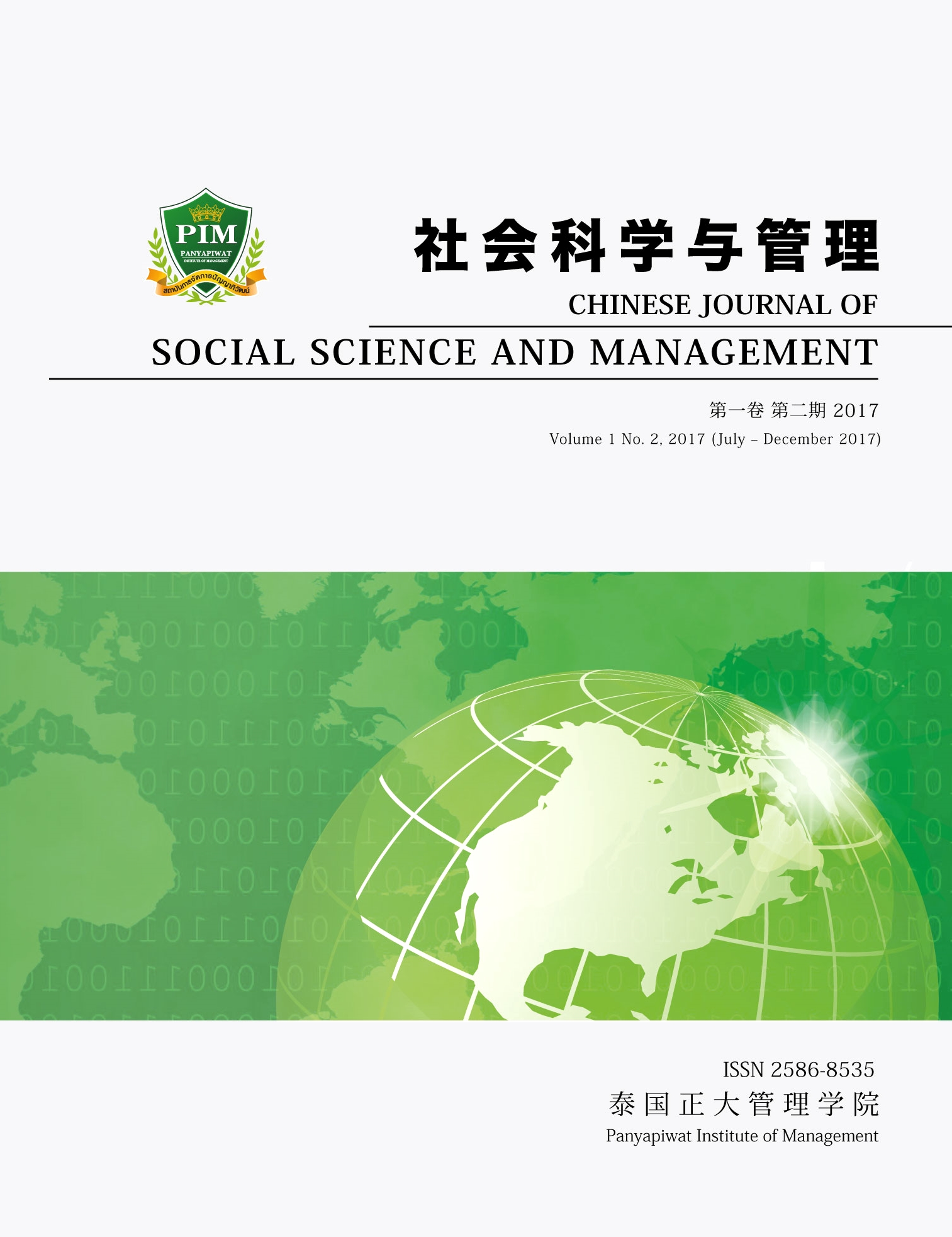A STUDY OF FACTORS AFFECTING CONSUMERS PURCHASING CHINA SICHUAN HOT POT IN THAILAND
Main Article Content
Abstract
This research is orientated at exploration. Based on Thai culture and food habits, we are analyzing
extent of consumers accept Chinese Sichuan Hotpot in Thailand and their particular needs. We are using
semi-structured interviewing method .19 respondents are interviewed face to face, individually and
deeply by making semi-structured interview outlines. All first-hand information are collected, then through
data coding and many steps of analysis , finally we got 13 factors affecting consumers purchasing process
of Sichuan Hotpot in Thai market: Chinese food culture background, friends, personal food taste, atmosphere,
distance, price, taste, dish, decoration, hygiene, time slot, service and information channel. We need to
notice that Chinese food culture has strong effect for Chinese and Thai customers if they are choosing
Sichuan Hotpot. Chinese customers mostly care about price, distance, dish and taste; Thai customers care
about taste, Chinese decoration, friends and hygiene more. But even same factors for different customers
have different explanations.
Article Details
Chinese Journal of Social Science and Management Editorial Division
The Office of Research and Development, Panyapiwat Institute of Management
85/1 Moo 2, Chaengwattana Rd., Bang Talat, Pakkred, Nonthaburi 11120, Thailand
Tel. 02 855 01048 E-mail: cjssm@pim.ac.th
References
程洁. (2011 年). 中式快餐在欧洲市场的品牌经营探讨. 华中科技大学, 23-30.
董钊. (2008 年). 成都餐饮消费现状研究. 西南财经大学, 59.
高坤、 余宜娴. (2015 年). 新形势下餐饮消费动机分析与激发策略. 市场营销, 第 516 期,156-158.
韩国圣、 李辉、 Alan Lew. (2015 年). 基于旅游与农业联系的游客餐饮感知研究: 评价维度与联系机制. 世界地理研究, 第 24 卷, 第 2 期.
黄丹. (2008 年). 影响节日餐饮消费行为意向的实证研究-以广州地区团年饭消费为例. 厦门大学.
简彩云. (2005 年). 顾客满意度指数测评模型比较与借鉴. 商业时代, 39-42.
姜楠. (2011 年). 建立文化因素的消费者决策模型. 北京邮电大学.
柯春媛. (2014 年). 茂名地区餐饮消费行为实证研究. 茂名职业技术学院, 156-158.
李治国. (2015 年). 试水 “互联网+信用” 订餐方式 上海浦东探索餐饮消费新模式. 经济日报,第 11 版.
李子晨. (2013 年). 信息变化给餐饮消费带来新变化. 国际商报, 第 A 04 版.
廖俊杰、 潘兆年. (2015 年). 重庆发布 2014 火锅行业红皮书. 中国食品安全报第 A 03 版.
刘畅、 周勤怡. (2014 年). 中青年女性基于审美需要的餐饮消费心理分析. 科技经济市场经营管理, 第 2 期, 59.
刘明. (2011 年). 我国餐饮业发展现状及其影响因素分析. 河北大学, 24-26.
刘瑞新、 侯兵. (2015 年). 游客在扬州餐的餐饮消费行为和满意度分析. 扬州大学, 旅游烹饪学院,扬州市, 40-44.
潘涛、 卢一. (2012 年). 川味火锅面临的问题及机遇研究. 四川旅游学院.
王梁. (2012 年). 非理性餐饮消费行为分析. 现代商贸工业期刊, 第 22 期, 64-65.
王灵恩、 成开魁. (2012 年). 中国餐饮消费的可持续发展策略研究. 中国人口、 资源与环境,第 22 卷, 第 5 期, 143-147.
王灵恩、 成开魁、 李群绩、 徐增让. (2013 年). 基于实证分析的拉萨市游客餐饮消费行为研究.资源科学, 第 35 卷, 第 4 期.
王瑞峰. (2011 年). 以内蒙古小肥羊为例阐述市场细分, 4P 的营销策略.
王昕兵. (2011 年). 论餐饮广告营销策略. 内蒙古师范大学, 16-23.
王雪. (2011 年). 我国餐饮细节营销研究-以四川火锅海底捞为例. 首都经济贸易大学.
温丽玲. (2011 年). 南宁市居民餐饮消费行为研究. 广西大学, 29-50.
张芳. (2014 年). 移动互联网情境下餐饮服务接触对各科行为意向的影响研究. 浙江大学.
郑淑丽. (2012 年). 中国文化软实力对泰国社会的影响. 重庆大学.
钟浩. (2013 年). 重庆火锅品牌视觉形象调查与研究. 重庆大学艺术学院.
周慧、 范香花. (2012 年). 休闲餐饮消费者需求行为特征的实证研究-以长沙市民为例. 江苏商论,商业经济, 24-26.
祝松. (2010 年). 餐饮消费顾客满意度调查报告. 中国食品报, 国内产经, 第 B02 版.
Babin, B. J., Lee, Y. K., Kim, E. J. & Miteh, G. (2005). Modelingeonsumer satisfaction and word-ofmouth: restaurant patronage in Korea. Journal of Services Marketing, 19(3), 133-139.
Bharath, M., Mellissa, M. & Pauline, S. (2004). The Historaunt: heritage tourism at Mickey’s Dining Car. Tourism Management, 25(4), 453-461.
Hanefors, M. & Mossberg, L. (2003). Searching for the Extraordinary Meal Experience. Journal of Business and Management, 9(3), 249-270.
Liu, Y. H. & Jang, S. C. (2009). Perceptions of Chinese restaurants in the U.S :What affects customer satisfaction and behavioral intentions. International Journal of Hospitality Management, 28(3), 338-348.
Lalwani, A. K. (2002). International orientation of Spouses and Household Purchase Decisions: The case of Restaurants. Service Industries Journal, 22(1), 184-200.
Marshall, D. & Bellb, R. (2003). Meal Construction: exploring the relationship between eating occasion and location. Food Quality and Preference, 14(1), 53-64.
Martinez, L. M. C., Molla-Bauza, M. B., Gomis, F. J. & Poreda, A. F. (2006). Influence of purchase place and consumption frequency over quality wine preferences. Food Quality and Preference, 17(5), 315-327.
Marta-pedraja, I. (2004). Perceived quality and Price: the impact on the satisfaction of restaurant customers. International Journal of Contemporary Hospitality Management, 16(6), 373-379.


